Hongbo Liu
VBench-2.0: Advancing Video Generation Benchmark Suite for Intrinsic Faithfulness
Mar 27, 2025Abstract:Video generation has advanced significantly, evolving from producing unrealistic outputs to generating videos that appear visually convincing and temporally coherent. To evaluate these video generative models, benchmarks such as VBench have been developed to assess their faithfulness, measuring factors like per-frame aesthetics, temporal consistency, and basic prompt adherence. However, these aspects mainly represent superficial faithfulness, which focus on whether the video appears visually convincing rather than whether it adheres to real-world principles. While recent models perform increasingly well on these metrics, they still struggle to generate videos that are not just visually plausible but fundamentally realistic. To achieve real "world models" through video generation, the next frontier lies in intrinsic faithfulness to ensure that generated videos adhere to physical laws, commonsense reasoning, anatomical correctness, and compositional integrity. Achieving this level of realism is essential for applications such as AI-assisted filmmaking and simulated world modeling. To bridge this gap, we introduce VBench-2.0, a next-generation benchmark designed to automatically evaluate video generative models for their intrinsic faithfulness. VBench-2.0 assesses five key dimensions: Human Fidelity, Controllability, Creativity, Physics, and Commonsense, each further broken down into fine-grained capabilities. Tailored for individual dimensions, our evaluation framework integrates generalists such as state-of-the-art VLMs and LLMs, and specialists, including anomaly detection methods proposed for video generation. We conduct extensive annotations to ensure alignment with human judgment. By pushing beyond superficial faithfulness toward intrinsic faithfulness, VBench-2.0 aims to set a new standard for the next generation of video generative models in pursuit of intrinsic faithfulness.
Simplifying CLIP: Unleashing the Power of Large-Scale Models on Consumer-level Computers
Nov 22, 2024



Abstract:Contrastive Language-Image Pre-training (CLIP) has attracted a surge of attention for its superior zero-shot performance and excellent transferability to downstream tasks. However, training such large-scale models usually requires substantial computation and storage, which poses barriers for general users with consumer-level computers. Motivated by this observation, in this paper we investigate how to achieve competitive performance on only one Nvidia RTX3090 GPU and with one terabyte for storing dataset. On one hand, we simplify the transformer block structure and combine Weight Inheritance with multi-stage Knowledge Distillation (WIKD), thereby reducing the parameters and improving the inference speed during training along with deployment. On the other hand, confronted with the convergence challenge posed by small dataset, we generate synthetic captions for each sample as data augmentation, and devise a novel Pair Matching (PM) loss to fully exploit the distinguishment among positive and negative image-text pairs. Extensive experiments demonstrate that our model can achieve a new state-of-the-art datascale-parameter-accuracy tradeoff, which could further popularize the CLIP model in the related research community.
Lotus: Diffusion-based Visual Foundation Model for High-quality Dense Prediction
Sep 26, 2024



Abstract:Leveraging the visual priors of pre-trained text-to-image diffusion models offers a promising solution to enhance zero-shot generalization in dense prediction tasks. However, existing methods often uncritically use the original diffusion formulation, which may not be optimal due to the fundamental differences between dense prediction and image generation. In this paper, we provide a systemic analysis of the diffusion formulation for the dense prediction, focusing on both quality and efficiency. And we find that the original parameterization type for image generation, which learns to predict noise, is harmful for dense prediction; the multi-step noising/denoising diffusion process is also unnecessary and challenging to optimize. Based on these insights, we introduce Lotus, a diffusion-based visual foundation model with a simple yet effective adaptation protocol for dense prediction. Specifically, Lotus is trained to directly predict annotations instead of noise, thereby avoiding harmful variance. We also reformulate the diffusion process into a single-step procedure, simplifying optimization and significantly boosting inference speed. Additionally, we introduce a novel tuning strategy called detail preserver, which achieves more accurate and fine-grained predictions. Without scaling up the training data or model capacity, Lotus achieves SoTA performance in zero-shot depth and normal estimation across various datasets. It also significantly enhances efficiency, being hundreds of times faster than most existing diffusion-based methods.
KUNPENG: An Embodied Large Model for Intelligent Maritime
Jul 12, 2024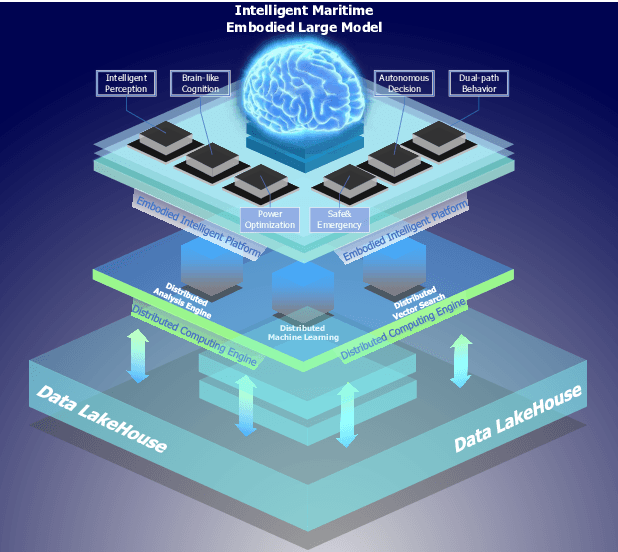
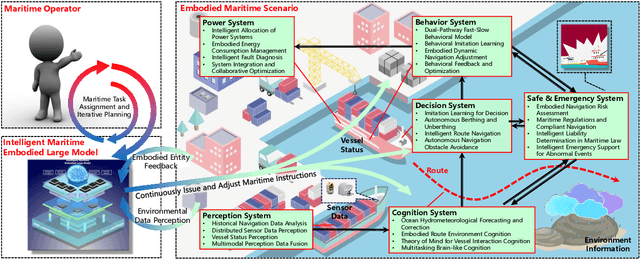
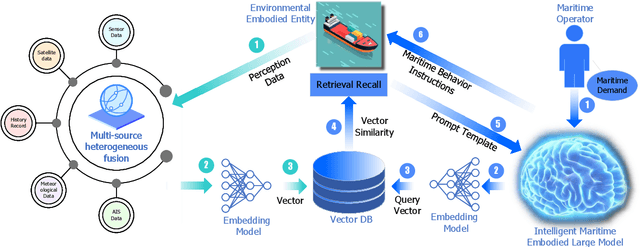
Abstract:Intelligent maritime, as an essential component of smart ocean construction, deeply integrates advanced artificial intelligence technology and data analysis methods, which covers multiple aspects such as smart vessels, route optimization, safe navigation, aiming to enhance the efficiency of ocean resource utilization and the intelligence of transportation networks. However, the complex and dynamic maritime environment, along with diverse and heterogeneous large-scale data sources, present challenges for real-time decision-making in intelligent maritime. In this paper, We propose KUNPENG, the first-ever embodied large model for intelligent maritime in the smart ocean construction, which consists of six systems. The model perceives multi-source heterogeneous data for the cognition of environmental interaction and make autonomous decision strategies, which are used for intelligent vessels to perform navigation behaviors under safety and emergency guarantees and continuously optimize power to achieve embodied intelligence in maritime. In comprehensive maritime task evaluations, KUNPENG has demonstrated excellent performance.
PTM-VQA: Efficient Video Quality Assessment Leveraging Diverse PreTrained Models from the Wild
May 28, 2024Abstract:Video quality assessment (VQA) is a challenging problem due to the numerous factors that can affect the perceptual quality of a video, \eg, content attractiveness, distortion type, motion pattern, and level. However, annotating the Mean opinion score (MOS) for videos is expensive and time-consuming, which limits the scale of VQA datasets, and poses a significant obstacle for deep learning-based methods. In this paper, we propose a VQA method named PTM-VQA, which leverages PreTrained Models to transfer knowledge from models pretrained on various pre-tasks, enabling benefits for VQA from different aspects. Specifically, we extract features of videos from different pretrained models with frozen weights and integrate them to generate representation. Since these models possess various fields of knowledge and are often trained with labels irrelevant to quality, we propose an Intra-Consistency and Inter-Divisibility (ICID) loss to impose constraints on features extracted by multiple pretrained models. The intra-consistency constraint ensures that features extracted by different pretrained models are in the same unified quality-aware latent space, while the inter-divisibility introduces pseudo clusters based on the annotation of samples and tries to separate features of samples from different clusters. Furthermore, with a constantly growing number of pretrained models, it is crucial to determine which models to use and how to use them. To address this problem, we propose an efficient scheme to select suitable candidates. Models with better clustering performance on VQA datasets are chosen to be our candidates. Extensive experiments demonstrate the effectiveness of the proposed method.
Ada-DQA: Adaptive Diverse Quality-aware Feature Acquisition for Video Quality Assessment
Aug 01, 2023Abstract:Video quality assessment (VQA) has attracted growing attention in recent years. While the great expense of annotating large-scale VQA datasets has become the main obstacle for current deep-learning methods. To surmount the constraint of insufficient training data, in this paper, we first consider the complete range of video distribution diversity (\ie content, distortion, motion) and employ diverse pretrained models (\eg architecture, pretext task, pre-training dataset) to benefit quality representation. An Adaptive Diverse Quality-aware feature Acquisition (Ada-DQA) framework is proposed to capture desired quality-related features generated by these frozen pretrained models. By leveraging the Quality-aware Acquisition Module (QAM), the framework is able to extract more essential and relevant features to represent quality. Finally, the learned quality representation is utilized as supplementary supervisory information, along with the supervision of the labeled quality score, to guide the training of a relatively lightweight VQA model in a knowledge distillation manner, which largely reduces the computational cost during inference. Experimental results on three mainstream no-reference VQA benchmarks clearly show the superior performance of Ada-DQA in comparison with current state-of-the-art approaches without using extra training data of VQA.
A Self-adaptive Neuroevolution Approach to Constructing Deep Neural Network Architectures Across Different Types
Nov 30, 2022Abstract:Neuroevolution has greatly promoted Deep Neural Network (DNN) architecture design and its applications, while there is a lack of methods available across different DNN types concerning both their scale and performance. In this study, we propose a self-adaptive neuroevolution (SANE) approach to automatically construct various lightweight DNN architectures for different tasks. One of the key settings in SANE is the search space defined by cells and organs self-adapted to different DNN types. Based on this search space, a constructive evolution strategy with uniform evolution settings and operations is designed to grow DNN architectures gradually. SANE is able to self-adaptively adjust evolution exploration and exploitation to improve search efficiency. Moreover, a speciation scheme is developed to protect evolution from early convergence by restricting selection competition within species. To evaluate SANE, we carry out neuroevolution experiments to generate different DNN architectures including convolutional neural network, generative adversarial network and long short-term memory. The results illustrate that the obtained DNN architectures could have smaller scale with similar performance compared to existing DNN architectures. Our proposed SANE provides an efficient approach to self-adaptively search DNN architectures across different types.
Weighted Concordance Index Loss-based Multimodal Survival Modeling for Radiation Encephalopathy Assessment in Nasopharyngeal Carcinoma Radiotherapy
Jun 23, 2022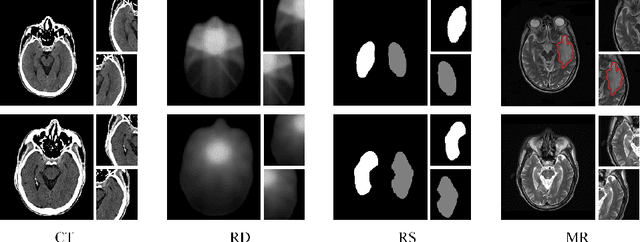

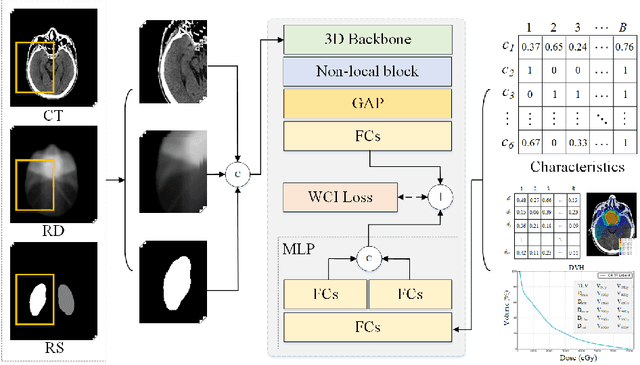

Abstract:Radiation encephalopathy (REP) is the most common complication for nasopharyngeal carcinoma (NPC) radiotherapy. It is highly desirable to assist clinicians in optimizing the NPC radiotherapy regimen to reduce radiotherapy-induced temporal lobe injury (RTLI) according to the probability of REP onset. To the best of our knowledge, it is the first exploration of predicting radiotherapy-induced REP by jointly exploiting image and non-image data in NPC radiotherapy regimen. We cast REP prediction as a survival analysis task and evaluate the predictive accuracy in terms of the concordance index (CI). We design a deep multimodal survival network (MSN) with two feature extractors to learn discriminative features from multimodal data. One feature extractor imposes feature selection on non-image data, and the other learns visual features from images. Because the priorly balanced CI (BCI) loss function directly maximizing the CI is sensitive to uneven sampling per batch. Hence, we propose a novel weighted CI (WCI) loss function to leverage all REP samples effectively by assigning their different weights with a dual average operation. We further introduce a temperature hyper-parameter for our WCI to sharpen the risk difference of sample pairs to help model convergence. We extensively evaluate our WCI on a private dataset to demonstrate its favourability against its counterparts. The experimental results also show multimodal data of NPC radiotherapy can bring more gains for REP risk prediction.
Siamese Encoder-based Spatial-Temporal Mixer for Growth Trend Prediction of Lung Nodules on CT Scans
Jun 07, 2022


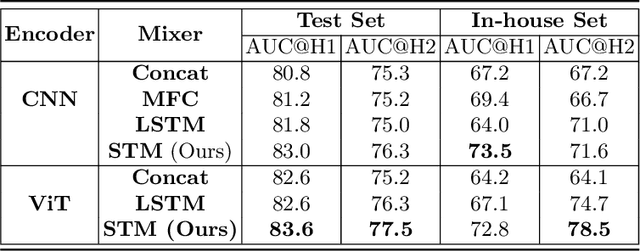
Abstract:In the management of lung nodules, we are desirable to predict nodule evolution in terms of its diameter variation on Computed Tomography (CT) scans and then provide a follow-up recommendation according to the predicted result of the growing trend of the nodule. In order to improve the performance of growth trend prediction for lung nodules, it is vital to compare the changes of the same nodule in consecutive CT scans. Motivated by this, we screened out 4,666 subjects with more than two consecutive CT scans from the National Lung Screening Trial (NLST) dataset to organize a temporal dataset called NLSTt. In specific, we first detect and pair regions of interest (ROIs) covering the same nodule based on registered CT scans. After that, we predict the texture category and diameter size of the nodules through models. Last, we annotate the evolution class of each nodule according to its changes in diameter. Based on the built NLSTt dataset, we propose a siamese encoder to simultaneously exploit the discriminative features of 3D ROIs detected from consecutive CT scans. Then we novelly design a spatial-temporal mixer (STM) to leverage the interval changes of the same nodule in sequential 3D ROIs and capture spatial dependencies of nodule regions and the current 3D ROI. According to the clinical diagnosis routine, we employ hierarchical loss to pay more attention to growing nodules. The extensive experiments on our organized dataset demonstrate the advantage of our proposed method. We also conduct experiments on an in-house dataset to evaluate the clinical utility of our method by comparing it against skilled clinicians.
Hybrid Genetic Algorithm for Cloud Computing Applications
Apr 22, 2014
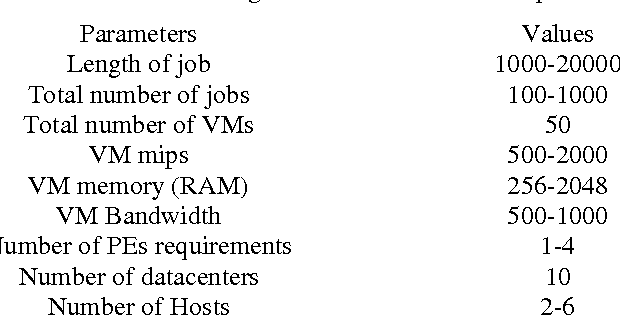


Abstract:In this paper with the aid of genetic algorithm and fuzzy theory, we present a hybrid job scheduling approach, which considers the load balancing of the system and reduces total execution time and execution cost. We try to modify the standard Genetic algorithm and to reduce the iteration of creating population with the aid of fuzzy theory. The main goal of this research is to assign the jobs to the resources with considering the VM MIPS and length of jobs. The new algorithm assigns the jobs to the resources with considering the job length and resources capacities. We evaluate the performance of our approach with some famous cloud scheduling models. The results of the experiments show the efficiency of the proposed approach in term of execution time, execution cost and average Degree of Imbalance (DI).
 Add to Chrome
Add to Chrome Add to Firefox
Add to Firefox Add to Edge
Add to Edge